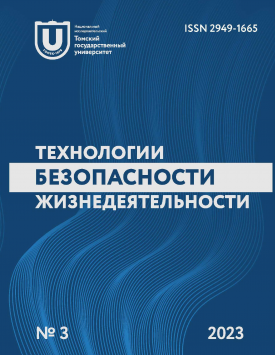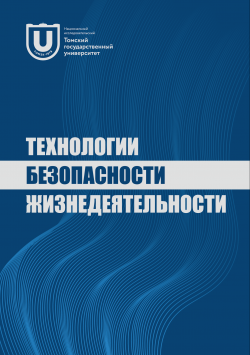The range of resistance of hydrobionts to medium contamination with manufactured nanoparticles
In addition to the safety issues of highly dispersed materials directly for humans and farm animals, of equal importance is their possible impact on the lower links of the food chains that form the ecosystem of trophic security. According to the law of equivalence, all environmental conditions necessary to sustain life have an equal role to play. Therefore, disturbances in the lower, usually less resilient elements of food chains can critically limit humanity’s existence. During the life cycle of nanomaterials, one of the most common pathways of entry into the biosphere is through aerosol transport with subsequent deposition on surface water or soil, or direct transport by soil water from storage or disposal sites. Therefore, hydrobionts are among the first links in contact with nanoparticles. An assessment was performed to estimate ecological and biological effects of metallic and binary nanoparticles (NPs) of various chemical nature and structural characteristics. Application of rapid toxicity tests using hydrobionts of various trophic levels (Escherihia coli, Chlorella vulgaris B., Paramecium caudatum, Daphnia magna S., Danio rerio) allowed to determine resistance range to NPs Ni, Pt, ZnO and CeO2. It was established that test reaction to contamination of water with NPs and development of adverse effects to phyto- and zooplankton is contingent on NPs physicochemical properties and sensitivity of hydrobionts. Concentrations of NPs not causing observed change of test reactions were determined. C. vulgaris B. was established to be the most vulnerable to contamination of medium with NPs; photosynthetic pigment quantity was determined to be the most sensitive parameter: nCeO2 L(E)Cio = 0.0007 mg/l, nNi L(E)Cio = 0.0015 mg/l, nZnO L(E)Cio = 0.0048 mg/l, nPt L(E)Cio = 0.033 mg/l. The highest resistance (L(E)C10 > 100 mg/l) to contamination shown by: E. Coli, D. magna S., D. rerio to nPt ; D. rerio. to nNi and nZnO, E. coli, P. caudatum to nCeO2; and D. rerio by the parameter ‘embryotoxicity’. The most vulnerable chains of trophic structure of communities were revealed as well as ways of disrupting food pyramid of an aquatic system. Range of resistance or range of concentrations within which biota retains resistance was shown to be an integral characteristic of NPs effects on ecosystems. The authors declare no conflicts of interests.
Keywords
resistance,
nanoparticles,
hydrobionts,
test-organism,
test-reaction,
dispersed systemsAuthors
| Morgalev Yuri N. | Tomsk State University | yu.morgalev@gmail.com |
| Morgalev Sergey Yu. | Tomsk State University | s.morgalev2@gmail.com |
| Kondratova Oksana V. | Tomsk State University | kov-2710@yandex.ru |
| Morgaleva Tamara G. | Tomsk State University | tg.morgaleva@gmail.com |
Всего: 4
References
Brar S.K., Verma M., Tyagi R.D., Surampalli R.Y. Engineered nanoparticles in wastewater and wastewater sludge-Evidence and impacts // Waste management. 2010. Vol. 30 (3). P. 504-520.
Karakoti A.S., Munusamy P., Hostetler K., Kodali V., Kuchibhatla S., Orr G., Pounds J.G., Teeguarden J.G., Thrall B.D., Baer D.R. Preparation and characterization challenges to understanding environmental and biological impacts of ceria nanoparticles // Surface and Interface Analysis. 2012. Vol. 44 (8). P. 882-889.
Shah V., Shah S., Shah H., Rispoli F.J., McDonnell K.T., Workeneh S., Karakoti A.S., Kumar A., Seal S. Antibacterial activity of polymer coated cerium oxide nanoparticles // PLoS One. 2012. Vol. 7 (10). P. e47827.
Taylor N.S., Merrifield R., Williams T.D., Chipman J.K., Lead J.R., Viant M.R. Molecular toxicity of cerium oxide nanoparticles to the freshwater alga Chlamydomonas reinhardtii is associated with supra-environmental exposure concentrations // Nanotoxicology. 2016. Vol. 10 (1). P. 32-41.
Sounderya N., Zhang Y. Use of core/shell structured nanoparticles for biomedical applications // Recent Patents on Biomedical Engineering (Discontinued). 2008. Vol. 1 (1). P. 34-42.
Chiu W., Khiew P., Cloke M., Isa D. et al. Heterogeneous seeded growth: synthesis and characterization of bifunctional Fe3O4/ZnO core/shell nanocrystals // The Journal of Physical Chemistry C. 2010. Vol. 114 (18). P. 8212-8218.
Ahn K. Y., Kwon K., Huh J., Kim G. T. et al. A sensitive diagnostic assay of rheumatoid arthritis using three-dimensional ZnO nanorod structure // Biosensors and bioelectronics. 2011. Vol. 28 (1). P. 378-385.
Ovissipour M., Roopesh S.M., Rasco B.A., Sablani S.S. Engineered nanoparticles (ENPs): Applications, risk assessment, and risk man agement in the agriculture and food sectors // Food Chemical Hazard Detection: Development and Application of New Technologies. 2014. P. 207-247.
Dastjerdi R., Montazer M. A review on the application of inorganic nano-structured materials in the modification of textiles: focus on anti-microbial properties // Colloids and surfaces B: Biointerfaces. 2010. Vol. 79 (1). P. 5-18.
Song W., Zhang J., Guo J., Zhang J. et al. Role of the dissolved zinc ion and reactive oxygen species in cytotoxicity of ZnO nanoparticles // Toxicology letters. 2010. Vol. 199 (3). P. 389-397.
Maurer-Jones M.A., Gunsolus I.L., Murphy C.J., Haynes C.L. Toxicity of engineered nanoparticles in the environment // Analytical chemistry. 2013. Vol. 85 (6). P. 3036-3049.
МУ 1.2.2634-10. Микробиологическая и молекулярно-генетическая оценка воздействия наноматериалов на представителей микробиоценоза: методические указания. М.: Федеральный центр гигиены и эпидемиологии Роспотребнадзора, 2010. 58 с.
Моргалёв Ю.Н., Моргалёва Т.Г., Григорьев Ю.С. Методика определения индекса токсичности нанопорошков, изделий из наноматериалов, нанопокрытий, отходов и осадков сточных вод, содержащих наночастицы, по изменению оптической плотности тест-культуры водоросли хлорелла (Сhlorella vulgaris Beijer). ФР.1.39.2010.09103.
Walz H. Phytoplankton Analyzer Phyto-PAM and Phyto-Win software V 1.45, System Components and Principles of Operation. О Heinz Walz GmbH, Germany, 2003. 135 S.
Моргалев Ю.Н., Хоч Н.С., Моргалева Т.Г., Дунаевский Г.Е., Моргалев С.Ю. Безопасность методов биоанализа наночастиц и наноматериалов: методическое руководство. Томск, 2010. 56 с.
Моргалев Ю.Н., Моргалева Т.Г., Григорьев Ю.С. Методика определения индекса токсичности нанопорошков, изделий из наноматериалов, нанопокрытий, отходов и осадков сточных вод, содержащих наночастицы, по смертности тест-организма Daphnia magna Straus. ФР 1.39.2010.09102.
OECD, Test No. 202: Daphnia sp. Acute Immobilisation Test, OECD Guidelines for the Testing of Chemicals, Section 2. Paris: OECD Publishing, 2004.
СТО ТГУ 143-2015. Наноматериалы и сверхтонкие материалы, отходы производства и потребления, осадок сточных вод, содержащий наночастицы. Водные дисперсные системы. Тест на индекс токсичности - смертности организма Данио Рерио. Томск, 2015.
OECD, Test No. 236: Fish Embryo Acute Toxicity (FET) Test, OECD Guidelines for the Testing of Chemicals, Section 2. Paris: OECD Publishing, 2013.
Globally harmonized system of classification and labelling of chemicals (GHS). Eighth revised edition. United Nations, 2019. P. 227249.
Приказ МПР России № 511 от 15 июня 2001 г. "Критерии отнесения опасных отходов к классу опасности для окружающей среды".
Morgalev S.Y., Morgaleva T.G., Morgalev Y.N., Gosteva I.A. Stability of disperse systems during bioassay of nanoecotoxicity with use of aquatic organisms // Advanced Materials Research. 2015. Vol. 1085. P. 424-429.
Morgaleva T., Morgalev Yu., Gosteva I., Morgalev S., Nesterenya D. Embryotoxicity of poorly soluble nanoparticles at various stages of Zebrafish Development // AIP Conference Proceedings. 2017. Vol. 1899 (1). Art. nubmer 050004. P. 1-9.
Morgalev Y.N., Kurovsky A.V., Gosteva I.A., Morgaleva T.G., Morgalev S.Yu., Burenina A.A. Influence of Metal-Containing Nanoparticles on the Content of Photosynthetic Pigments of Unicellular Alga Chlorella vulgaris Baijer // Nano Hybrids and Composites. 2017. Vol. 13. P. 255-262.
Моргалёв Ю.Н., Моргалёва Т.Г., Моргалёв С.Ю. Передача маркерных наночастиц Pt в трехзвенной трофической цепи Chlorella Beijer-Daphnia magna Straus-Cyprinus carpio // Российские нанотехнологии. 2022. Т. 17, № 2. С. 225-233.
Hoecke K. V., Quik J.T., Mankiewicz-Boczek J., Schamphelaere K.A.D. et al. Fate and effects of CeO2 nanoparticles in aquatic ecotoxicity tests // Environmental science & technology. 2009. Vol. 43(12). P. 4537-4546.
Lopes S., Ribeiro F., Wojnarowicz J., Lojkowski W. et al. Zinc oxide nanoparticles toxicity to Daphnia magna: size dependent effects and dissolution // Environmental toxicology and chemistry. 2014. Vol. 33 (1). P. 190-198.
Liu J., Fan D., Wang L., Shi L.I.L.I., Ding J., Chen Y., Shen S. Effects of ZnO, CuO, Au, and TiO2 nanoparticles on Daphnia magna and early life stages of zebrafish Danio rerio // Environment Protection Engineering. 2014. Vol. 40 (1). P. 139-149.
Aruoja V., Pokhrel S., Sihtmae M., Mortimer M., Madler L., Kahru A. Toxicity of 12 metal-based nanoparticles to algae, bacteria and protozoa // Environmental Science: Nano. 2015. Vol. 2(6). P. 630-644.
Pendashte H., Shariati F., Keshavarz A., Ramzanpour Z. Toxicity of zinc oxide nanoparticles to Chlorella vulgaris and Scenedesmus dimorphus algae species // World Journal of Fish and Marine Sciences. 2013. Vol. 5 (5). P. 563-570.
Becaro A.A., Jonsson C.M., Puti F.C., Siqueira M.C. et al. Toxicity of PVA-stabilized silver nanoparticles to algae and microcrustaceans // Environmental Nanotechnology, Monitoring & Management. 2015. Vol. 3. P. 22-29.
Pakrashi S., Dalai S., Prathna T.C., Trivedi S. et al. Cytotoxicity of aluminium oxide nanoparticles towards fresh water algal isolate at low exposure concentrations // Aquatic Toxicology. 2013. Vol. 132. P. 34-45.
Xin Q., Rotchell J.M., Cheng J., Yi J., Zhang Q. Silver nanoparticles affect the neural development of zebrafish embryos // Journal of Applied Toxicology. 2015. Vol. 35 (12). P. 1481-1492.
Gong N., Shao K., Feng W., Lin Z., Liang C., Sun Y. Biotoxicity of nickel oxide nanoparticles and bio-remediation by microalgae Chlorella vulgaris // Chemosphere. 2011. Vol. 83 (4). P. 510-516.
Griffitt R.J., Luo J., Gao J., Bonzongo J.C., Barber D.S. Effects of particle composition and species on toxicity of metallic nanomaterials in aquatic organisms // Environmental Toxicology and Chemistry: An International Journal. 2008. Vol. 27 (9). P. 1972-1978.
Kovriznych J.A., Sotnikova R., Zeljenkova D., Rollerova E., Szabova E. Long-term (30 days) toxicity of NiO nanoparticles for adult zebrafish Danio rerio // Interdisciplinary Toxicology. 2014. Vol. 7 (1). P. 23-26.
Mortimer M., Kasemets K., Kahru A. Toxicity of ZnO and CuO nanoparticles to ciliated protozoa Tetrahymena thermophila // Toxicology. 2010. Vol. 269 (2-3). P. 182-189.

